OFF GRID POWER
HOW TO GENERATE IT?
This page provides information about what is required for an off grid power installation.
1. DOING YOUR OWN ELECTRICAL WORK.
Any installers, who installs solar system and connects this to the public electricity grid, needs to be a licensed electrician plus he also needs to have a DC license in addition. When the installation is finished this electrician needs to sign off on a form, stating his license numbers.
Doing DIY electrical work is illegal. The rules state you need to be qualified or licensed, without really stating what qualified means.
But with all those things, if you do a completely independent off grid installation, there is no sign off form needed. So who is qualified then?
If you have received training and instructions on what to do, and have a fall back possibility to ask questions, are you now qualified?
2. LET ME EXPLAIN HOW THE OFF-GRID MARKET WORKS.
- The bulk of the equipment is made overseas and needs to be imported. Sometimes an agent does that, or the company has a subsidiary in Australia.
- Then we have a wholesaler, who distributes to contractors, installers or retailers.
Because this solar business is virtually a closed industry, some installers can make huge markups and profits.
I managed to get a resale account with some large wholesalers of this type of equipment, and I can supply this at reasonable prices, but only for off grid installations. I have priced some of the quotes from contractors or installers and I was astounded and this is what I found:
- The equipment was often supplied with a 100% markup. And all the contractor has to do is order the equipment and get it delivered. There was no stock on hand investment.
- Then to top it off the quote also included installation between $4000 and $8000. That accounts for several weeks work for 2 men.
And the problem is, there is no alternative, they are all on the same wavelength.
When I supply the equipment, I supply it with instructions and costed at a modest margin. But I will only do that for complete OFF-GRID.
3. WHAT ARE WE TALKING ABOUT, WHEN WE MENTION A GRID.
The dictionaries say a grid is a series of parallel lines or sometimes crossed lines. In the electric sphere the lines are wires criss-crossing the country side, to distribute electricity from the generator to the end user.
So when we have the generator being a power station and you are being charged for the electricity you use, then we have a public grid.
If you are both the power generator and the end user, then you have a private grid. That is also referred to as Off-grid, because you are not on the public grid.
The installation rules are there to protect the generator, any installer and the end user and maybe also the environment. Things have to be safe!
There are such things as the protection of the individuals freedom. This might mean, if an individual wants to subject himself to a risk, he should be allowed to do that. Provided he does not become a burden on society.
WHAT EQUIPMENT DO WE NEED FOR A PRIVATE GRID?
4. SOLAR PANELS.
The solar panels will create electric energy from the sun’s visible light radiation. Those panels create DC and most panels create nominally 52V each panel. The wattage a panel can produce now is 450W and this used to be 200W not so long ago. But there are solar panels and solar panels.
- Solar panels can last 15 years or so. But they start with an efficiency of around 20-25%. This efficiency will reduce over time and the decay will also accelerate over time. That means a 10 year old solar panel may not be broken, but it’s efficiency might now be 15%.
- Solar panels collect dust form the wind. that dust cakes onto the panel and rain will not remove it. Hence the panels need a yearly (sometimes more frequent) wash with just cold lightly soapy water. NO SOLVENTS or SCOURERS!
- Mixing different brands or rating of solar panels that are connected to the same inverter is not advisable. But you can have multiple banks of solar panels each with their own inverter.
I have 2 large frames each with 6 panels @ 330W making say 4kW.
Plus the 2 small frames have 4 panels @ 415W making say 3.3kW. Total 7.3kW.

5. A GRID TIED INVERTER or Solar inverter.
This inverter converts the DC voltage from the solar panels into AC. The word grid tied means that this inverter will only do its job, if it can see an active AC grid at its output terminals. The trick is now that the AC power it creates must exactly follow the phase and voltage of the active grid it sees. If there is no grid at the terminal, the inverter shuts down.
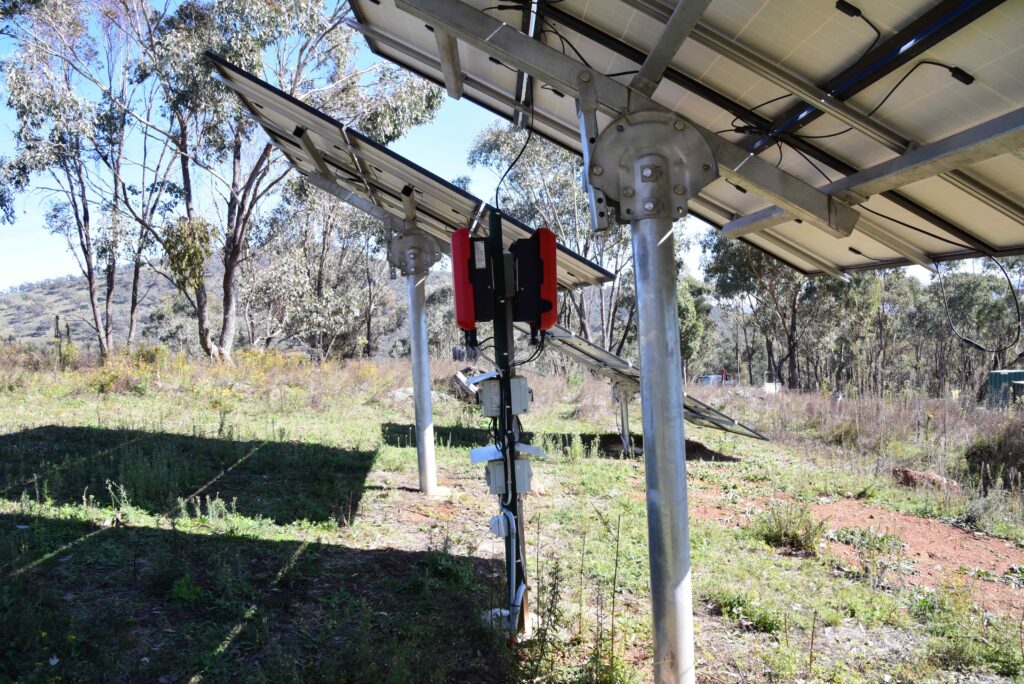
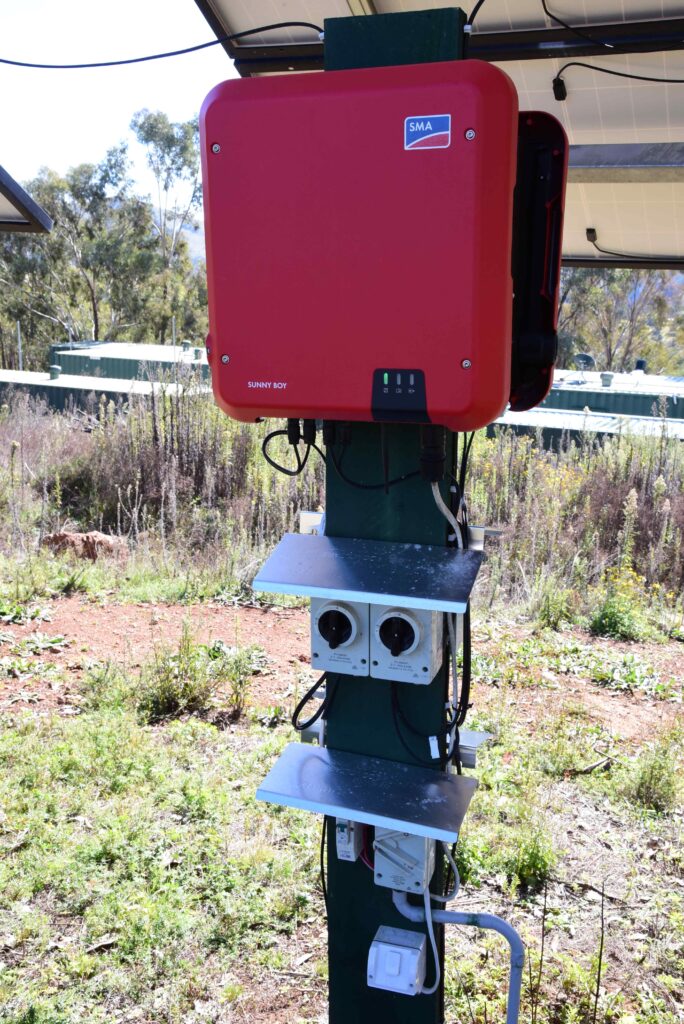
Continuing what you need for a private grid.
6. A BANK OF BATTERIES.
In a second location the bank of batteries is yet another source of electric energy. Once more this is a DC source. The voltage can vary from 12V, 24V, 36V and 52V etc. The energy in the batteries cannot be used as is. There are several types of batteries.
- I have chosen to go with the more expensive Lithium Ion batteries. They should last 10 years or more and they can be drawn down to 10-20% of the full charge. They are a tricky device, and can only be charged by dedicated devices.
- The alternative is 12V or 24V lead acid batteries. They are a lot cheaper, but they only last 3 to 5 years. In addition they can only be drawn down to 50% of their full charge.
- The life of a battery is not determined by years, but it often works out that way. More important factors are:
- The number of charges and discharges.
- The regular depth of discharge.
- Sudden very heavy loads on the battery and how often do they occur.
- Exposing batteries to extreme temperatures.
- The regular magnitude of the charging current.
- All these things add up over time and some batteries handle it well and others don’t.
I have 2 boxes with 4 batteries of 2.5kW each, making (2 x 4 x 2.5) = 20kW.
Plus I have 1 box with 4 batteries of 5kW each, making also 20kW. Those two sets of batteries are unfortunately not compatible, so they have to run on different systems. (COMPLICATED!)

7. A BATTERY MANAGEMENT INVERTER.
This inverter takes the DC energy from the battery and creates an AC grid of 230 Volts. It also controls the voltage and the phase of the grid. There is a second task, which is checking the state of charge of the batteries. Let’s look at the control actions of the inverter with respect to the battery health:
- It can give a signal that the batteries need charging. This inverter has 2 inlets, one with DC from the batteries and one connected to a standby generator. A generator equipped with auto start can be turned on and off by the inverter. I am not using that feature.
- When the State of Charge (SOC) reaches the lowest setpoint, it will shutdown the complete grid, including the solar panels.
- When the SOC reaches 99%, my inverters will change the grid frequency slightly (1-2 Hz) for a few seconds. The solar inverter picks that up and shuts down the solar panels.
- When the SOC reaches 100%, the inverter will stop drawing charge current from whatever device is connected, either solar panels or generator or another grid. (As could be the situation in my installation.)
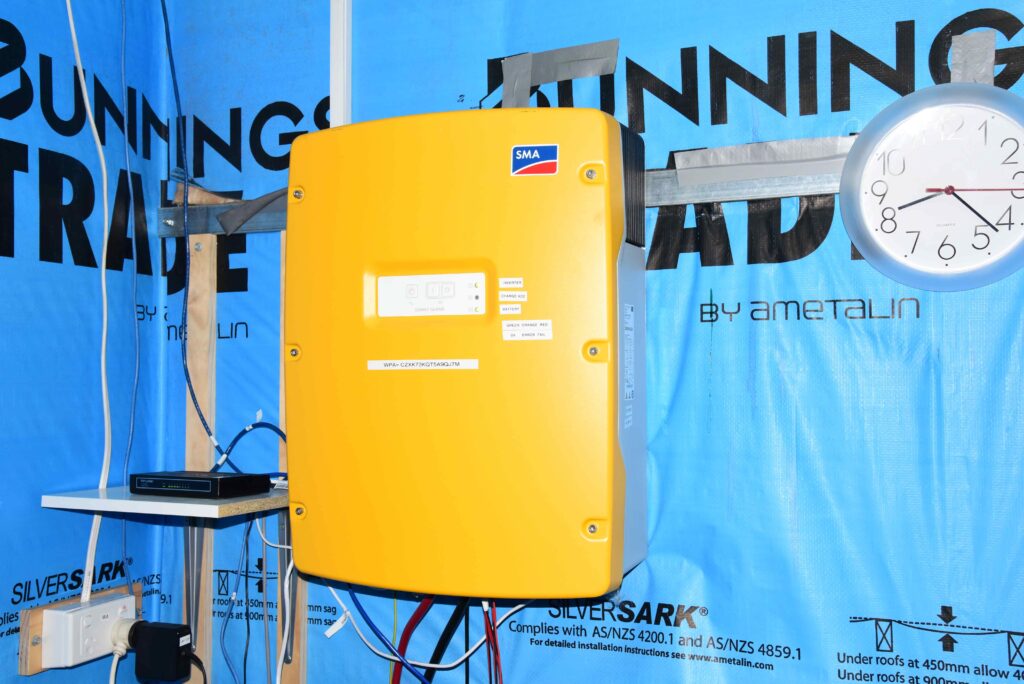
8. HOW DOES THE INVERTER MANAGE THE GENERATOR AND BATTERIES?
Most battery manager inverters have a relay that can switch on a generator when the stage of charge (SOC) of the batteries is below a setpoint.
The software that comes with the inverter can produce a continuous chart of the batteries SOC. Monitoring this chart allows the grid owner to plan his load, when to run certain operations, or not, and when to charge and for how long. Most people elect to operate the generator manually when needed, because that power is expensive.
This is my 6th generator. All prior ones have been pensioned off. The 2KVA is there (as a stand by), if I have a problem with the large one.
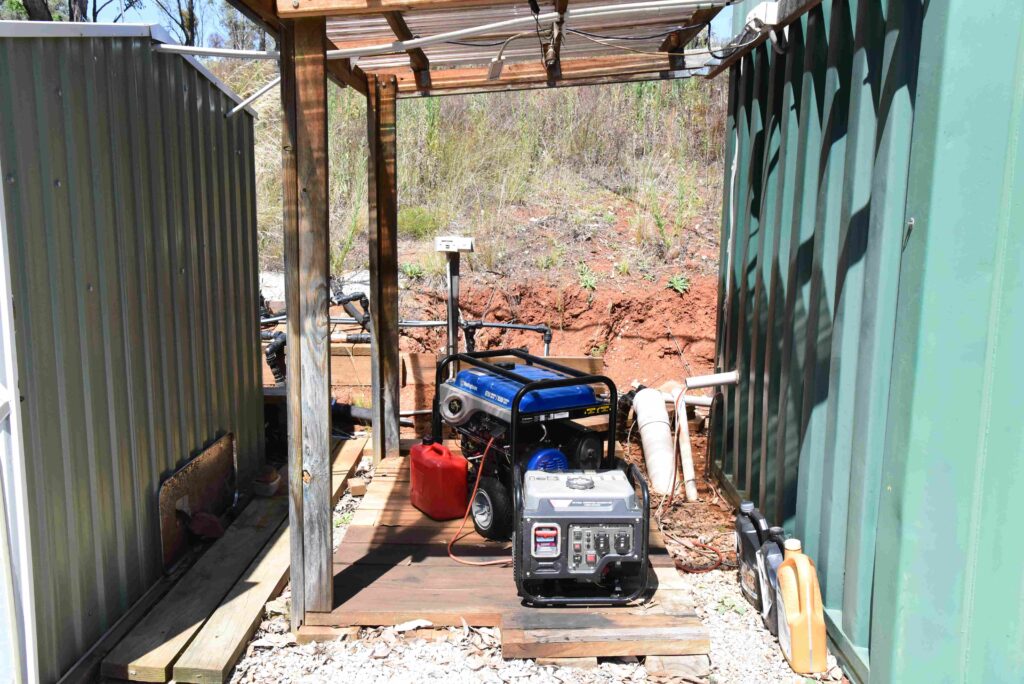
9. LAST, BUT NOT LEAST, EVERY INSTALLATION NEEDS A SWITCHBOARD. Plus lots of cables!
A switchboard controls which circuits are on and each circuit also has a residual current devices for safety. The second board on the right monitors every one of my 14 end circuits and also my 6 sources. Because of the incompatibility of the batteries, there are some 30 relays behind the switchboard panel, to prevent mixing out-of-phase power sources (as that will create big sparks). (The relays work as lock-outs.)
But don’t worry, most people don’t need to go to this extreme.
But operating in conjunction with the inverter’s SOC chart and the AMP reading drawn by certain circuits you can make well informed choices.
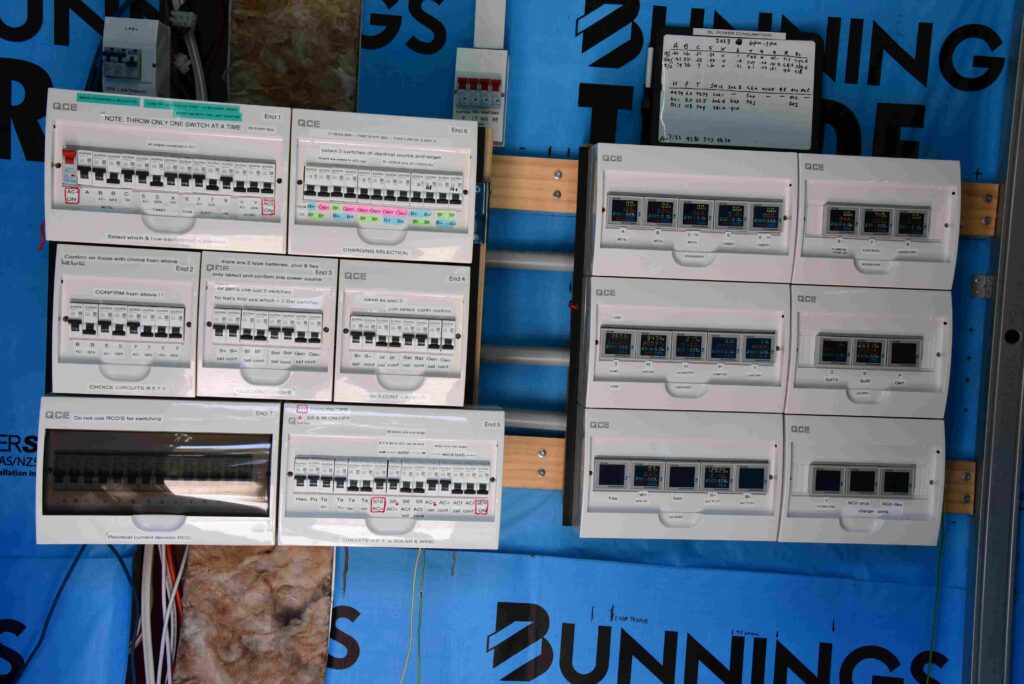
10. You may be keen to go off grid, but there are some serious considerations. If there is no power at your location, then going off grid is almost the only option. Bringing power via new transmission lines to a spot is extremely expensive. My neighbour spent $80,000 to bring the power to his home, yet I could have built 2 or 3 off-grid systems for that price, because of his low power consumption. Mind you a friend was quoted $120,000 (for 5km inland), but he went off-grid.
11. Here is another story, about a closed industry.
We are mugs in Australia!
- When the Tesla power wall was launched it did cost about AU$12000. The same unit in the USA cost US$3000, converted AU$4000. Now we have to add some importing costs plus a moderate margin for the importer, let’s say $6000. Once more another 100% markup. And a similar story about the incinerating toilet. (US$3500 to AU$8000.)
12. YET, I NEED TO GIVE SOME WARNINGS ABOUT GOING OFF GRID.
- Do not think that you can save on your electricity cost, because that is not true at this point in time. The kWh cost is the same if not more. By investing in off grid power you have basically paid for your power bills in advance. But in 10, 15 maybe 20 years you will have to replace all this equipment, but now at a higher $value. {However if energy prices keep going up, you might still be on the winning side.}
- If you think that running on off grid is a set and forget, once more not true. You need to monitor things daily.
- And then if there is a breakdown, who do you call? NOBODY. You are the trouble shooter, repair man and spare parts manager.
- Please do not think you can operate an off-grid system without a generator. When it rains the solar panels have almost no output. (mine fall from 18 Amps to 1-2 Amp.)
- You might say I buy more batteries, but they are the expensive part of the system. Then choose more solar panels, but that is of no use. My solar panels have the batteries full by lunchtime, but I struggle after 1 or 2 days solid rain.
- Let me explain the cost of generator electricity. The generator uses about 10L of petrol per 1.5 hours. At 20 Amps (75% of its capabilities) the generator gives 4.6kW/hr. So in 1.5 hours that is 6.9kWhr. The fuel cost for that time is $20. So, the power cost is (20/6.9)=$2.90 per kWh. That is almost 6 times higher than current public grid price. NOT VERY DESIRABLE.
OK, am I trying to talk you out of it? No, I am trying to make sure that you enter this phase with your eyes wide open, and there will be no false expectations! I can teach you about electricity, safe practices, and wiring methods, and prepare you to do the work yourself.
13. I have written an Essay (or Ebook) about electricity and electronics under the category engineering. This essay is available from my shop. It handles mostly what is there and what the components do or sometimes how they work. There is also a section about wiring 230V circuits plus the safety aspects. I also spend some time on what electricity can do to the human body.
Electricity is dangerous, because it acts without warning.
If things are warm (or Hot), you can feel that and you can take precautions. Electricity does not have that feature. When you notice anything, the destructive process is already happening and it is often too late already.
If you have absorbed all this let’s go to the nitty gritty costing page.
